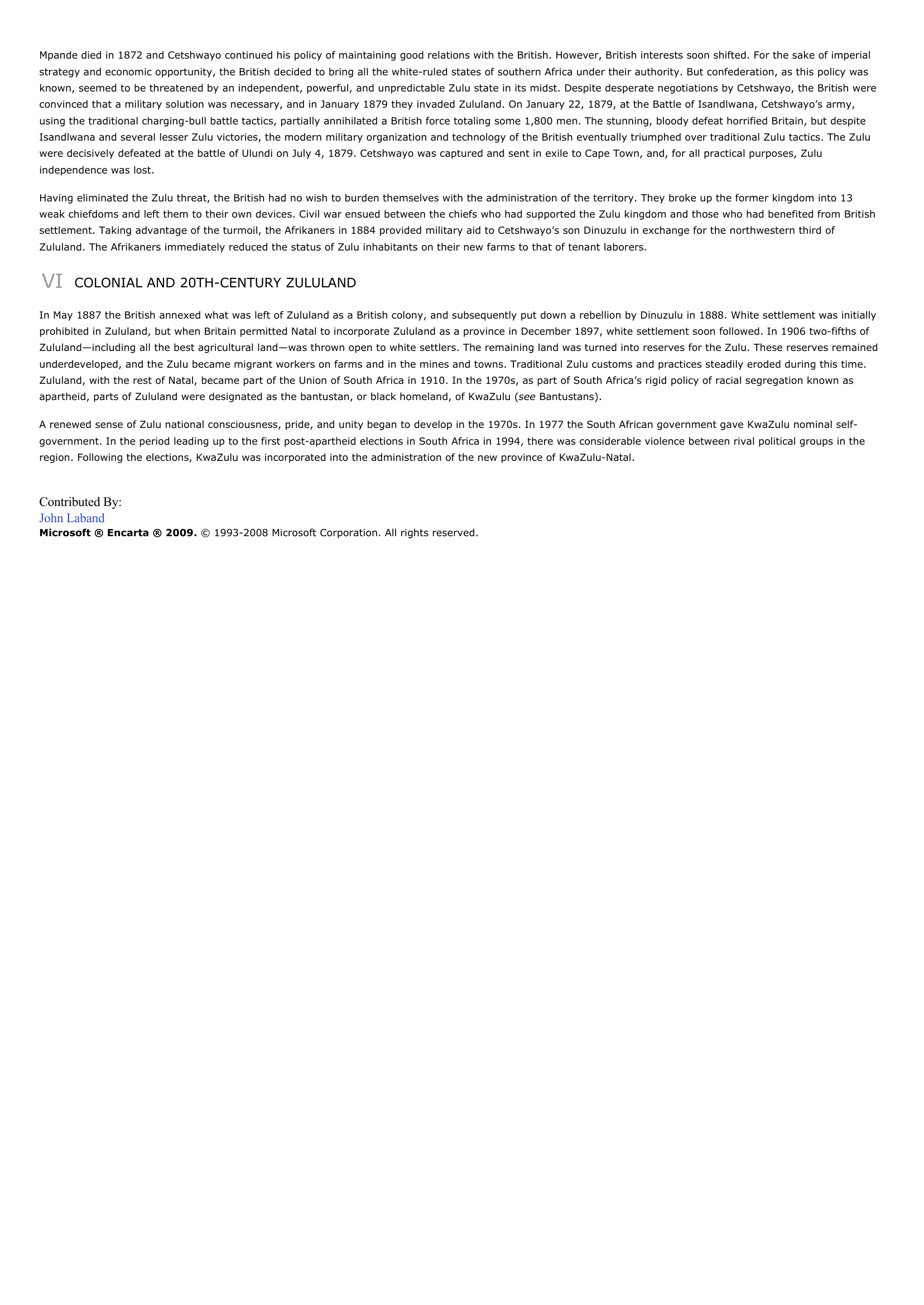Zululand.
Publié le 20/08/2013

Extrait du document
«
Mpande died in 1872 and Cetshwayo continued his policy of maintaining good relations with the British.
However, British interests soon shifted.
For the sake of imperialstrategy and economic opportunity, the British decided to bring all the white-ruled states of southern Africa under their authority.
But confederation, as this policy wasknown, seemed to be threatened by an independent, powerful, and unpredictable Zulu state in its midst.
Despite desperate negotiations by Cetshwayo, the British wereconvinced that a military solution was necessary, and in January 1879 they invaded Zululand.
On January 22, 1879, at the Battle of Isandlwana, Cetshwayo’s army,using the traditional charging-bull battle tactics, partially annihilated a British force totaling some 1,800 men.
The stunning, bloody defeat horrified Britain, but despiteIsandlwana and several lesser Zulu victories, the modern military organization and technology of the British eventually triumphed over traditional Zulu tactics.
The Zuluwere decisively defeated at the battle of Ulundi on July 4, 1879.
Cetshwayo was captured and sent in exile to Cape Town, and, for all practical purposes, Zuluindependence was lost.
Having eliminated the Zulu threat, the British had no wish to burden themselves with the administration of the territory.
They broke up the former kingdom into 13weak chiefdoms and left them to their own devices.
Civil war ensued between the chiefs who had supported the Zulu kingdom and those who had benefited from Britishsettlement.
Taking advantage of the turmoil, the Afrikaners in 1884 provided military aid to Cetshwayo’s son Dinuzulu in exchange for the northwestern third ofZululand.
The Afrikaners immediately reduced the status of Zulu inhabitants on their new farms to that of tenant laborers.
VI COLONIAL AND 20TH-CENTURY ZULULAND
In May 1887 the British annexed what was left of Zululand as a British colony, and subsequently put down a rebellion by Dinuzulu in 1888.
White settlement was initiallyprohibited in Zululand, but when Britain permitted Natal to incorporate Zululand as a province in December 1897, white settlement soon followed.
In 1906 two-fifths ofZululand—including all the best agricultural land—was thrown open to white settlers.
The remaining land was turned into reserves for the Zulu.
These reserves remainedunderdeveloped, and the Zulu became migrant workers on farms and in the mines and towns.
Traditional Zulu customs and practices steadily eroded during this time.Zululand, with the rest of Natal, became part of the Union of South Africa in 1910.
In the 1970s, as part of South Africa’s rigid policy of racial segregation known asapartheid, parts of Zululand were designated as the bantustan, or black homeland, of KwaZulu ( see Bantustans).
A renewed sense of Zulu national consciousness, pride, and unity began to develop in the 1970s.
In 1977 the South African government gave KwaZulu nominal self-government.
In the period leading up to the first post-apartheid elections in South Africa in 1994, there was considerable violence between rival political groups in theregion.
Following the elections, KwaZulu was incorporated into the administration of the new province of KwaZulu-Natal.
Contributed By:John LabandMicrosoft ® Encarta ® 2009. © 1993-2008 Microsoft Corporation.
All rights reserved..
»
↓↓↓ APERÇU DU DOCUMENT ↓↓↓





